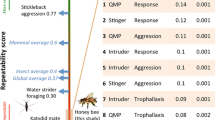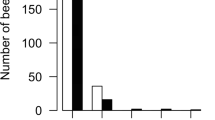Abstract
Variability exists among worker honey bees for components of division of labor. These components are of two types, those that affect foraging behavior and those that affect life-history characteristics of workers. Variable foraging behavior components are: the probability that foraging workers collect (1) pollen only; (2) nectar only; and (3) pollen and nectar on the same trip. Life history components are: (1) the age the workers initiate foraging behavior; (2) the length of the foraging life of a worker; and (3) worker length of life. We show how these components may interact to change the social organization of honey bee colonies and the lifetime foraging productivity of individual workers. Selection acting on foraging behavior components may result in changes in the proportion of workers collecting pollen and nectar. Selection acting on life-history components may affect the size of the foraging population and the distribution of workers between within nest and foraging activities. We suggest that these components define possible sociogenic “pathways” through which colony-level natural selection can change social organization. These pathways may be analogous to developmental pathways in the morphogenesis of individual organisms because small changes in behavioral or life history components of individual workers may lead to major changes in the organizational structure of colonies.
Similar content being viewed by others
References
Adams J, Rothman ED, Kerr WE, Paulino ZL (1977) Estimation of the number of sex alleles and queen matings from diploid male frequencies in a population of Apis mellifera. Genetics 86:583–596
Breed MD, Rogers KB (1991) The behavior genetics of colony defense in honeybees: genetic variability for guarding behavior. Behav Genet 21:295–303
Breed MD, Robinsion GE, Page RE (1990) Division of labor during honey bee colony defense. Behav Ecol Sociobiol 27:395–401
Calderone NW, Page RE (1988) Genotypic variability in age polyethism and task specialisation in the honey bee, Apis mellifera (Hymenoptera: Apidae). Behav Ecol Sociobiol 22:17–25
Calderone NW, Page RE (1991) The evolutionary genetics of division of labor in colonies of the honey bee (Apis mellifera). Am Nat 138:69–92
Calderone NW, Page RE (1992) Effects of interactions among genetically diverse nestmates on task specialization by foraging honey bees (Apis mellifera). Behav Ecol Sociobiol 30:219–226
Calderone NW, Robinson GE, Page RE (1989) Genetic structure and division of labor in honeybee societies. Experientia 45:765–767
Crozier RH, Consul PC (1976) Conditions for genetic polymorphisms in social Hymenoptera under selection at the colony level. Theor Popul Biol 10:1–9
Darwin CR (1859) On the Origin of Species, 6th edn. Macmillan, New York [1962]
Frumhoff PC, Baker J (1988) A genetic component to division of labour within honey bee colonies. Nature 333:358–361
Gary NE, Lorenzen K (1976) A method for collecting the honeysac contents from honeybees. J Apic Res 15:73–79
Gary NE, Lorenzen K (1990) Vacuum devices for capturing and partitioning commingled subpopulations of honey bees (Hymenoptera: Apidae). Ann Entomol Soc Am 83:1152–1154
Guzmán-Novoa E, Gary NE (1993) Genotypic variability of components of foraging behavior in honey bees (Hymenoptera: Apidae). J Econ Entomol 86:715–721
Hellmich RL, Kulincevic JM, Rothenbuhler WC (1985) Selection for high and low pollen-hoarding honey bees. J Hered 76:155–158
Hillesheim E, Koeniger N, Moritz RFA (1989) Colony performance in honeybees (Apis mellifera capensis Esch.) depends on the proportion of subordinate and dominant workers. Behav Ecol Sociobiol 24:291–296
Kolmes SA, Winston ML, Fergusson LA (1989) The division of labor among worker honey bees (Hymenoptera: Apidae): the effects of multiple patrilines. J Kans Entomol Soc 62:80–95
Laidlaw HH (1977) Instrumental insemination of honey bee queens. Dadant, Hamilton
Laidlaw HH (1979) Contemporary queen rearing. Dadant, Hamilton
Milne CP (1980) Laboratory measurement of honey production in the honeybee. 2. Longevity or length of life of caged workers. J Apic Res 19:172–175
Moritz RFA, Hillesheim E (1985) Inheritance of dominance in honeybees (Apis mellifera capensis Esch.). Behav Ecol Sociobiol 17:87–89
Neukirch A (1982) Dependence of the lifespan of the honey bee (Apis mellifera) upon flight performance and energy consumption. J Comp Physiol 146:35–40
Oldroyd BP, Rinderer TE, Buco SM (1991) Honey bees dance with their super sisters. Anim Behav 42:121–129
Oldroyd BP, Rinderer TE, Buco SM, Beaman LD (1993) Genetic variance in honey bees for preferred foraging distance. Anim Behav 45:323–332
Oster GF, Wilson EO (1978) Caste and ecology in the social insects. Princeton University Press, Princeton
Owen RE (1986) Colony-level selection in the social insects: single locus additive and non-additive models. Theor Popul Biol 29:198–234
Owen RE (1989) The genetics of colony-level selection. In: Breed MD, Page RE (eds) The genetics of social evolution. Westview Press, Boulder, pp 31–59
Page RE (1986) Sperm utilization in social insects. Annu Rev Entomol 31:297–320
Page RE, Erickson EH (1988) Reproduction by worker honey bees. Behav Ecol Sociobiol 23:117–126
Page RE, Laidlaw HH (1988) Full sisters and super sisters: a terminological paradigm. Anim Behav 36:944–945
Page RE, Robinson GE (1991) The genetics of division of labour in honey bee colonies. Adv Insect Physiol 23:118–169
Page RE, Robinson GE, Britton DS, Fondrk MK (1992) Genotypic variability for rates of development in worker honeybees (Apis mellifera). Behav Ecol 3:173–180
Robinson GE, Page RE (1988) Genetic determination of guarding and undertaking in honey-bee colonies. Nature 333:356–358
Robinson GE, Page RE (1989) Genetic determination of nectar foraging, pollen foraging, and nest-site scouting in honey bee colonies. Behav Ecol Sociobiol 24:317–323
Robinson GE, Page RE, Fondrk MK (1990) Intracolonial behavioral variation in worker oviposition, oophagy, and larval care in queenless honey bee colonies. Behav Ecol Sociobiol 26:315–323
Robinson GE, Page RE, Strambi C, Strambi A (1989) Hormonal and genetic control of behavioral integration in honey bee colonies. Science 246:109–112
Robinson GE, Page RE, Strambi C, Strambi A (1992) Colony integration in honey bees: mechanisms of behavioral reversion. Ethology 90:336–348
Rothenbuhler WC, Page RE (1989) Genetic variability for temporal polyethism in colonies consisting of similarly-aged worker honey bees. Apidologie 29:433–437
Schmid-Hempel P, Kacelnik A, Houston AI (1985) Honeybees maximize efficiency by not filling their crop. Behav Ecol Sociobiol 17:61–66
Seeley TD (1989) The honey bee colony as a superorganism. Am Sci 77:546–553
Sokal RR, Rohlf FJ (1981) Biometry. Freeman, New York
Visscher PK (1989) A quantitative study of worker reproduction in honey bee colonies. Behav Ecol Sociobiol 25:247–254
Wilson DS, Sober E (1989) Reviving the superorganism. J Theor Biol 136:337–356
Winston ML (1987) The biology of the honey bee. Harvard University Press, Cambridge
Winston ML, Katz SJ (1982) Foraging differences between crossfostered honeybee workers (Apis mellifera) of European and Africanized races. Behav Ecol Sociobiol 10:125–129
Author information
Authors and Affiliations
Additional information
Correspondence to: R.E. Page, Jr.
Rights and permissions
About this article
Cite this article
Guzmán-Novoa, E., Page, R.E. & Gary, N.E. Behavioral and life-history components of division of labor in honey bees (Apis mellifera L.). Behav Ecol Sociobiol 34, 117–409 (1994). https://doi.org/10.1007/BF00167332
Received:
Accepted:
Issue Date:
DOI: https://doi.org/10.1007/BF00167332




